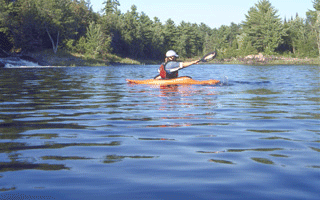The Back Stroke - Whitewater
Most paddlers will develop a forward stroke that is powerful enough to get them where they need to go, but very few paddlers ever reach that same level of comfort with their back stroke!
Taking the time to practise your back paddling will go a long way toward improving your overall skills. Not only will the practice make your stroke more effective, you'll have an increased awareness when you find yourself backward on the river. Working on the back stroke is also a great way to help prevent shoulder injuries. For anatomical reasons, shoulder dislocations are anterior (forward) over 90% of the time. The back stroke strengthens important front shoulder muscles that the forward stroke does not. This may not stop a dislocation from happening, but it can certainly help prevent it. So let's take a look at a few things to keep in mind when practising backward paddling.
First of all, you need to get used to watching where you're going when practising. You might laugh at these little words of wisdom, but you'll be amazed at how often paddlers get caught up with the simple task of paddling in a straight line and end up backing right into something or someone.
Choose one shoulder to look over, and do so every few strokes. You'll find it's easiest to look over that shoulder as you reach to take a stroke on that same side, since your body will be partly turned in that direction. If you know that you're not going to run into anything, you can use landmarks in front of you to help keep you going straight. For example, you could choose a tree in the distance and be fairly certain that if you keep that tree in the same position relative to the direction in which your bow is pointing, then you should be on track. However, it is still important to practise looking over your shoulder, since this is something you'll need to be able to do comfortably later on.
As whitewater kayaks have shrunk and been designed with slicier edges, back paddling with your body in a forward position has become all that much more important. In this position, you have the most control over your kayak, and, more importantly, it helps keep your stern edges from catching water. But there will be times when paddling in this aggressive forward position won't be enough to keep your stern edges from diving underwater, particularly when paddling against the current, crossing through an eddy line, or using a small playboat. In these cases, you'll need to use the same boat tilt method that we discussed for the forward stroke (see the forward stroke article).
By tilting your boat a little and very briefly into each of your strokes, you can slice your bow slightly under water, which keeps your stern on top of the water. The amount you'll actually tilt your boat and pull your bow underwater will depend on the situation, but do remember that your back stroke will be most efficient when your boat is kept flat to the water, so don't overuse this boat tilt technique.
Now let's look at the dynamics of the back stroke itself. Your stroke will begin just behind your hip and end at your toes. At first you'll probably find that your top hand is quite low during your strokes because of all the corrections you're making to keep yourself moving in the right direction. Although there's nothing wrong with this, it needs to be understood that the ideal back stroke has your top hand between shoulder and eye level, where you'll get the most push from your stroke.
Another way to make your back stroke more effective is to apply the second Golden Rule (see Golden Rule article for more details) and use the power of your torso rotation to your advantage. As you should already know, the way you get the power of torso rotation into your strokes is by winding up your upper body. Think about turning your chest to face the knee on the stroking side of the kayak as you plant each stroke. Now as you push on your back stroke, think about driving your back shoulder forward. You'll be amazed at how much longer you can paddle and how much more power you'll get by sharing the workload with your upper torso muscles.

Keeping your weight forward and tilting your boat slightly into each stroke helps keep the stern out of the water as you back paddle.
Ken Whiting was the 1997/98 World Whitewater Freestyle Champion. He has produced an award-winning series of instructional kayaking books and DVDs, and leads kayaking trips to Chile. Look for his new book 'The Ultimate Guide to Whitewater Kayaking', and video 'The Ultimate Guide to Sea Kayaking'. Check out www.helipress.com
Related Articles
Even though they are flipping over, missing their gates and failing their maneuvers, they still look…
In this video, we're going to look at five kayaking tips that will help make you a better paddler, or…
As a member of the US Surf Kayaking Team I had the honor and privilege to compete in the world…
Eddy turns are the foundation for paddling in current, enabling you to enter and exit river and tidal…


